Overview
The article "10 Essential Insights for Navigating ABA Education" aims to support parents and professionals involved in Applied Behavior Analysis (ABA) education by providing key strategies and resources. It emphasizes the importance of:
- Collaboration
- Early intervention
- Ongoing assessment
These elements are crucial as they significantly enhance the effectiveness of ABA practices and improve outcomes for children with autism and ADHD. This is supported by various research findings and expert insights shared throughout the content.
Navigating the world of ABA can be overwhelming, but understanding these essential insights can make a meaningful difference. By collaborating with educators and therapists, parents can create a supportive environment that fosters growth. Early intervention is vital; the sooner support is provided, the better the outcomes for children. Ongoing assessment ensures that strategies are tailored to meet each child's unique needs, promoting their development effectively.
As you read through the article, consider the challenges you may face. Have you found yourself wondering how to best support your child? You're not alone. Many parents share similar concerns, and this article aims to address those emotions while offering practical advice. We encourage you to reflect on your experiences and share them with us in the comments or through our newsletter.
Ultimately, the goal is to empower you with knowledge and resources that can enhance your journey in ABA education. Together, we can make a positive impact on the lives of children with autism and ADHD, fostering a brighter future for them and their families.
Introduction
In the world of Applied Behavior Analysis (ABA) education, the journey for parents and professionals is often filled with both challenges and triumphs. As they navigate the complexities of supporting children with autism and ADHD, having access to comprehensive resources is essential. This is where ASD Media shines as a beacon of support, providing a wealth of articles, webinars, and community forums designed to empower families and educators.
Understanding the core principles of ABA is just the beginning. Advocating for individualized education plans is crucial, and this article explores essential strategies and techniques that not only enhance learning outcomes but also foster a collaborative environment. By emphasizing the significance of early intervention and ongoing assessment, it underscores how tailored approaches can unlock a child's potential, paving the way for meaningful progress in their educational journey.
We invite you to join us in exploring these resources and strategies, sharing your experiences and insights as we work together to support our children in their learning paths.
ASD Media: Comprehensive Resources for ABA Education Support
At ASD Media, we recognize the unique journey of parents and professionals participating in ABA education. We provide a wealth of resources designed specifically to support you, including articles, webinars, and community forums that address common challenges and share effective strategies. By utilizing these resources, you can stay updated on the latest advancements in ABA practices while connecting with others who are facing similar difficulties, fostering a nurturing sense of community and assistance.
Did you know that the average salary for ABA therapists in Alabama is around $50,000? This highlights the profession's vital role in supporting children with autism and ADHD. As the apricoott team beautifully states, "ABA therapy can be used to teach individuals with autism how to interact with their peers and family members." This reinforces the therapy's effectiveness in educational settings, showcasing its importance in creating meaningful connections.
In the ever-evolving field of ABA, ongoing professional development is essential for therapists to stay informed about new research and techniques. We encourage you to engage with our community and receive the latest information on ASD by signing up for email updates. This way, you can remain informed and empowered on your journey through your ABA education, equipped with the necessary knowledge and support.
Understanding the Core Principles of Applied Behavior Analysis (ABA)
The core principles of Applied Behavior Analysis (ABA) include reinforcement, punishment, and the thoughtful use of antecedents to shape behavior. Understanding these principles is crucial for caregivers and professionals aiming to create personalized interventions that cater to individual needs.
For instance, positive reinforcement—like verbal praise, tokens, or engaging activities—plays a vital role in encouraging desired behaviors, fostering a nurturing and effective learning environment. Research underscores the effectiveness of reinforcement strategies, revealing that a blend of verbal praise, tokens, and preferred activities keeps reinforcement engaging and dynamic, significantly enhancing skill development, especially in communication and social interactions.
The Lovaas study, for example, highlighted the power of positive reinforcement, showing notable improvements in communication skills among participants. This finding emphasizes the importance of collaboration between parents and educators to implement effective reinforcement strategies.
Moreover, grasping the balance between reinforcement and punishment is essential in the context of ABA education. While reinforcement aims to increase desired behaviors, punishment is intended to decrease undesired ones. This dual approach, when applied thoughtfully, nurtures a comprehensive understanding of a child's behavior across various settings, ultimately leading to more successful interventions.
As we look ahead to 2025, the principles of ABA continue to evolve, reinforcing the significance of these foundational concepts in shaping effective educational strategies. Cristina Cordeiro, founder of Dream Big Children’s Center, beautifully states, "Drawing on her knowledge in special education and behavioral support, Cristina aimed to establish a comforting environment that feels like home for families."
Additionally, the recent article titled 'Mastering the Art of Structured Learning in Autism Therapy' offers valuable guidance on implementing discrete trial training (DTT) in ABA education, further illustrating the evolving nature of this field.
To effectively apply these principles, parents are encouraged to actively collaborate with educators, ensuring a consistent approach to reinforcement and punishment in their child’s learning environment.
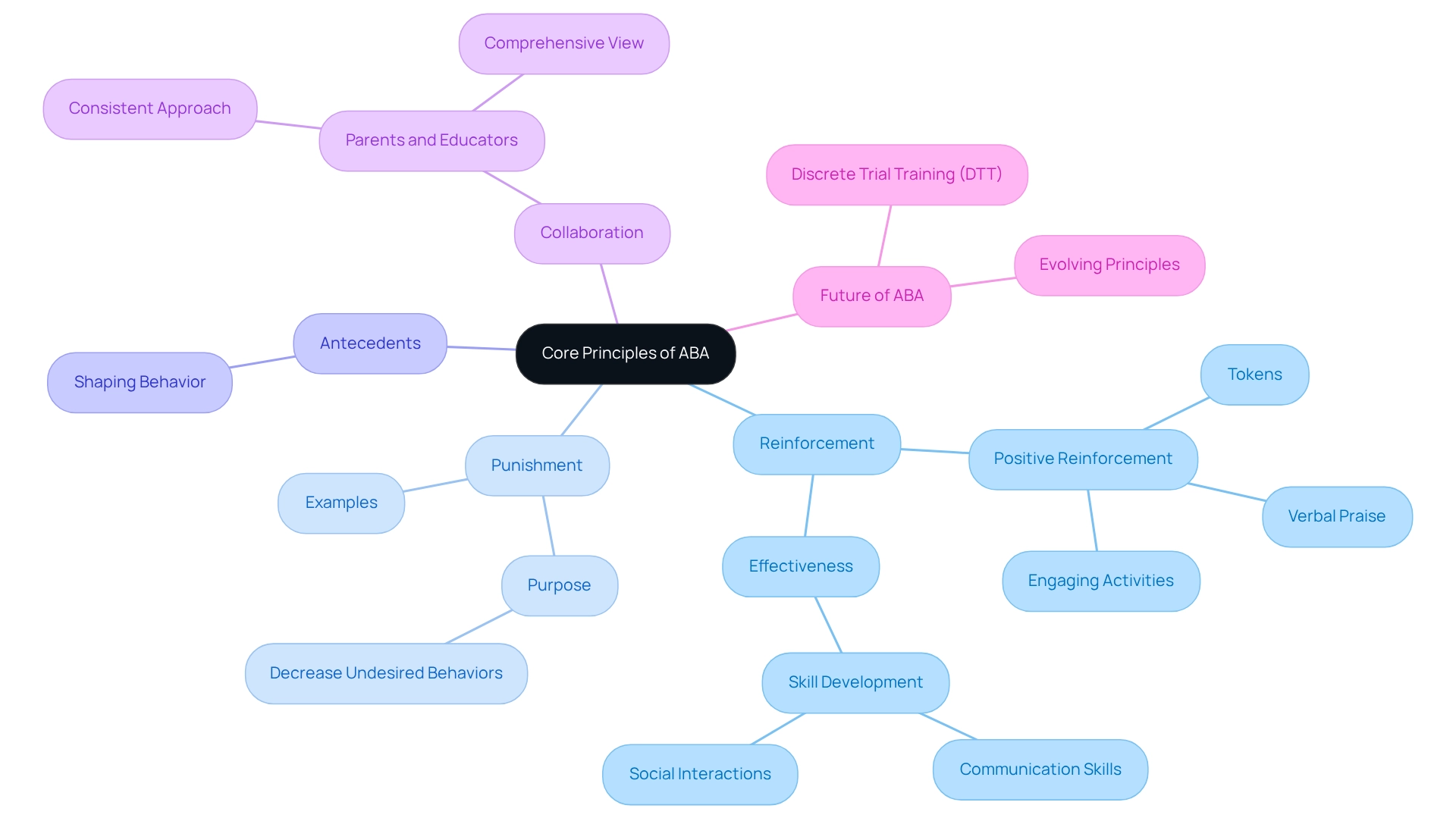
The Importance of Early Intervention in ABA Education
Research highlights the vital role of early intervention in enhancing outcomes for children with autism and ADHD. When ABA education begins at a young age, children can develop essential skills more effectively, leading to improved social interactions and academic success. For instance, studies indicate that early intervention through ABA education not only aids in skill acquisition but also equips young individuals with coping strategies to manage their symptoms, fostering better relationships with family and peers.
The Bruckner Foundation supports this perspective, noting that children who engage in early ABA education demonstrate significant progress in managing sensory overload and articulating their needs. Furthermore, Autism Speaks invests over $30 million each year in autism research, underscoring the critical importance of early intervention.
While many children benefit from these early ABA education interventions, it is essential to acknowledge that some may experience mixed outcomes, as noted by Makrygianni and Reed. Additionally, ABA education can be customized to meet the unique needs of each child, further enhancing its effectiveness.
Parents and guardians are strongly encouraged to seek evaluations and initiate interventions as soon as possible to fully harness these benefits. The positive effects of early ABA education can lead to lasting improvements in the lives of young individuals, making it a crucial step in their development.
Key Techniques Used in ABA Therapy for Effective Learning
Understanding the key techniques in ABA education can be a game-changer for families navigating the complexities of autism and ADHD. Techniques like discrete trial training (DTT), natural environment training (NET), and task analysis are designed to facilitate effective learning and can be seamlessly integrated into daily routines.
- DTT, for instance, has shown remarkable results in skill acquisition. Research highlights a moderate effect size, with a partial eta squared for interaction effect of 0.130, underscoring its effectiveness in breaking down complex tasks into manageable steps. This targeted instruction allows for meaningful reinforcement and progress.
- On the other hand, NET emphasizes the importance of teaching skills within natural contexts. This approach not only promotes generalization but also encourages the real-world application of learned behaviors. Many families have reported promising outcomes with NET, particularly in enhancing social skills and adaptive behaviors. It's heartening to see how these techniques can transform daily interactions and foster growth.
- Task analysis also plays a vital role in ABA therapy. By identifying and teaching each component of a complex skill step-by-step, it provides a structured approach that can ease the learning process. Insights from the case study titled 'Effects of Discrete Trials, Mass Trials, and Naturalistic Environment Training' further support the effectiveness of these methods, showcasing their positive impact on improving outcomes for autistic individuals.
Parents can effortlessly incorporate these techniques into their daily routines, reinforcing learning opportunities and promoting skill development in their children. As Qian Yu insightfully remarked, 'More methodologically rigorous studies will be essential to determine the precise potential of ABA-based interventions for youth with ASD.' By comprehending and applying these essential methods, families can navigate the intricacies of ABA education more efficiently, ultimately enhancing results for their loved ones.
Have you tried any of these techniques? Share your experiences with us, and let's support each other in this journey.
Utilizing Positive Reinforcement in ABA Education
Positive reinforcement is a cornerstone of ABA education, where rewards are thoughtfully given after desired behaviors to encourage their recurrence. Effective rewards—be it praise, tokens, or privileges—are most impactful when tailored to align with a young person's individual preferences. Research indicates that consistent application of positive reinforcement can lead to remarkable improvements in various aspects of functioning for individuals with autism spectrum disorder (ASD), particularly in socialization and communication skills.
For instance, case studies reveal that children who receive timely and meaningful rewards for positive behaviors demonstrate heightened engagement and motivation within learning environments. One notable study highlighted the beneficial effects of ABA methods, showcasing advancements in socialization skills and communication abilities. Current trends in ABA education underscore the necessity of collaboration among professionals, including BCBAs, speech therapists, and occupational therapists, to create a cohesive reinforcement strategy that supports the child's development. As Steven Zauderer, CEO & Founder of CrossRiverTherapy, insightfully notes, "It's important to collaborate closely with the BCBA and other specialists involved in the program to ensure that the young person's progress is consistently monitored and the treatment plan is modified as needed."
By cultivating an environment where positive behaviors are recognized and rewarded, parents play a vital role in their children's progress. This nurturing approach not only unlocks their potential but also enhances their overall quality of life, making a significant difference in their journey.

Advocating for Individualized Education Plans (IEPs) in ABA
Personalized Education Plans (IEPs) are vital for young learners undergoing ABA education in educational settings. These tailored plans ensure that each child's unique needs are addressed, fostering their growth and success. It's crucial for caregivers to be actively involved in the IEP process; parents must advocate for their child's specific needs to ensure that appropriate goals and services are incorporated.
Research, like the case analysis 'Early Intervention in ABA Therapy,' shows that children who receive early support through ABA therapy demonstrate significant improvements in various life skills, leading to greater independence. By familiarizing themselves with the IEP framework, parents can effectively communicate their child's needs to educators, creating a collaborative environment where everyone works together for the child's benefit.
Moreover, studies indicate that the quality of IEPs is positively associated with student progress, especially for young individuals with ASD. Ruble et al. highlight that 'the quality of IEPs was positively associated with students’ goal progress.' As parents engage in this process, they not only support their child's educational journey but also contribute to the effective implementation of ABA education strategies in schools. It is important to acknowledge that IEPs for students with ASD in their final year of school do not always meet federal law standards. This emphasizes the need for vigilant advocacy from parents to ensure their children receive the support they deserve.
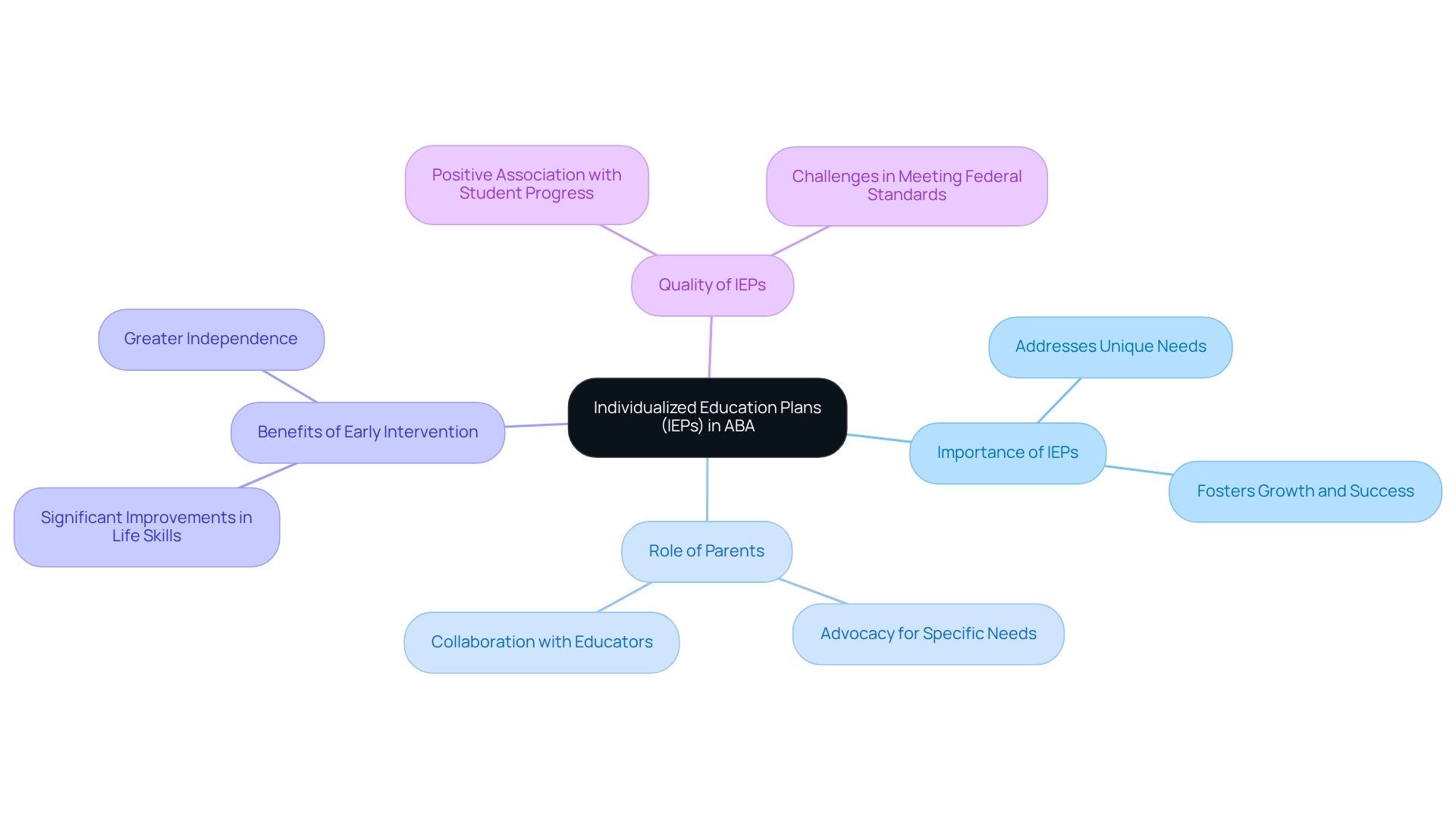
The Role of Ongoing Assessment in ABA Programs
Continuous evaluations in ABA programs are vital for effectively monitoring a young person's progress and identifying areas that may need adjustment. By utilizing robust data collection and analysis techniques, therapists and parents can make informed decisions about interventions that truly matter. It’s important for parents to actively engage in this process, seeking updates and participating in discussions about their child's development. A study evaluating the adaptive behavior outcomes of youth undergoing ABA intervention revealed that even minimal exposure to ABA can lead to significant improvements in adaptive behavior. This finding suggests that positive outcomes are achievable with varying degrees of service intensity.
Furthermore, a meta-analytic study highlighted improvements in IQ scores among youth with ASD who underwent ABA interventions, reinforcing the method's effectiveness. These findings emphasize the necessity of establishing a structured framework for continuous evaluations, addressing challenges related to treatment access, and ensuring that interventions are tailored to meet each individual's unique needs. As Karen J Coleman, PhD, MS, noted, "These findings suggest that even in a state context where there is mandated commercial insurance coverage for ABA... there are health system implementation challenges that may limit the extent to which interventions translate to meaningful patient outcomes."
By incorporating regular evaluations, families can navigate the complexities of ABA therapy more effectively, ensuring that their young one's progress is consistently monitored and supported. Engaging in this process not only fosters a deeper understanding of their child's journey but also empowers parents to advocate for the best possible outcomes.
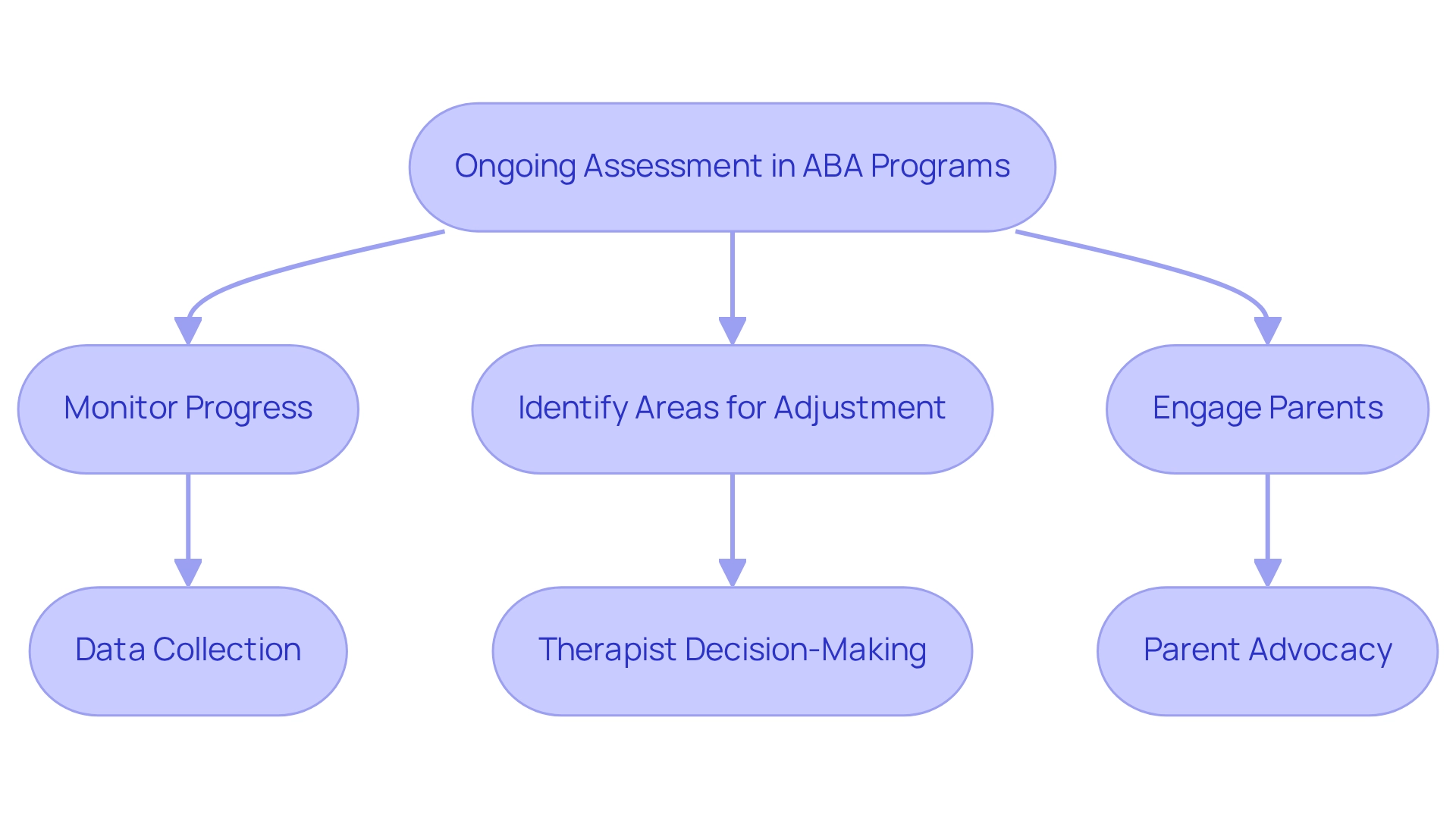
Collaborating with Professionals and Other Parents in ABA Education
Building strong connections with ABA experts and fellow caregivers is essential for establishing a solid support network. Parents are encouraged to actively seek opportunities to collaborate with therapists, educators, and other families. This exchange of experiences and effective strategies not only nurtures a sense of belonging but also enhances the overall assistance provided to young individuals. Research indicates that when parents engage in 36 hours or more of ABA intervention, significant improvements in IQ and adaptive skills are observed. This underscores the importance of sustained and cooperative efforts in supporting children with autism.
Moreover, ABA practices promote beneficial peer interactions, fostering enhanced social skills and emotional development for individuals with autism. Case studies illustrate that these collaborations can lead to improved emotional management and coping techniques for young individuals, ultimately supporting their autonomy and integration into society. As ASD Media poignantly states, "These stories illustrate how ABA therapy can positively impact children's lives, leading them toward independence and better integration into society."
By collaborating, caregivers and professionals can create a broader support system that significantly influences the outcomes of ABA education. To initiate this collaboration, parents can begin by:
- Joining local support groups
- Participating in online forums
- Connecting with other families and professionals in the field
Taking these steps not only empowers parents but also enriches the community, fostering a nurturing environment for all involved.
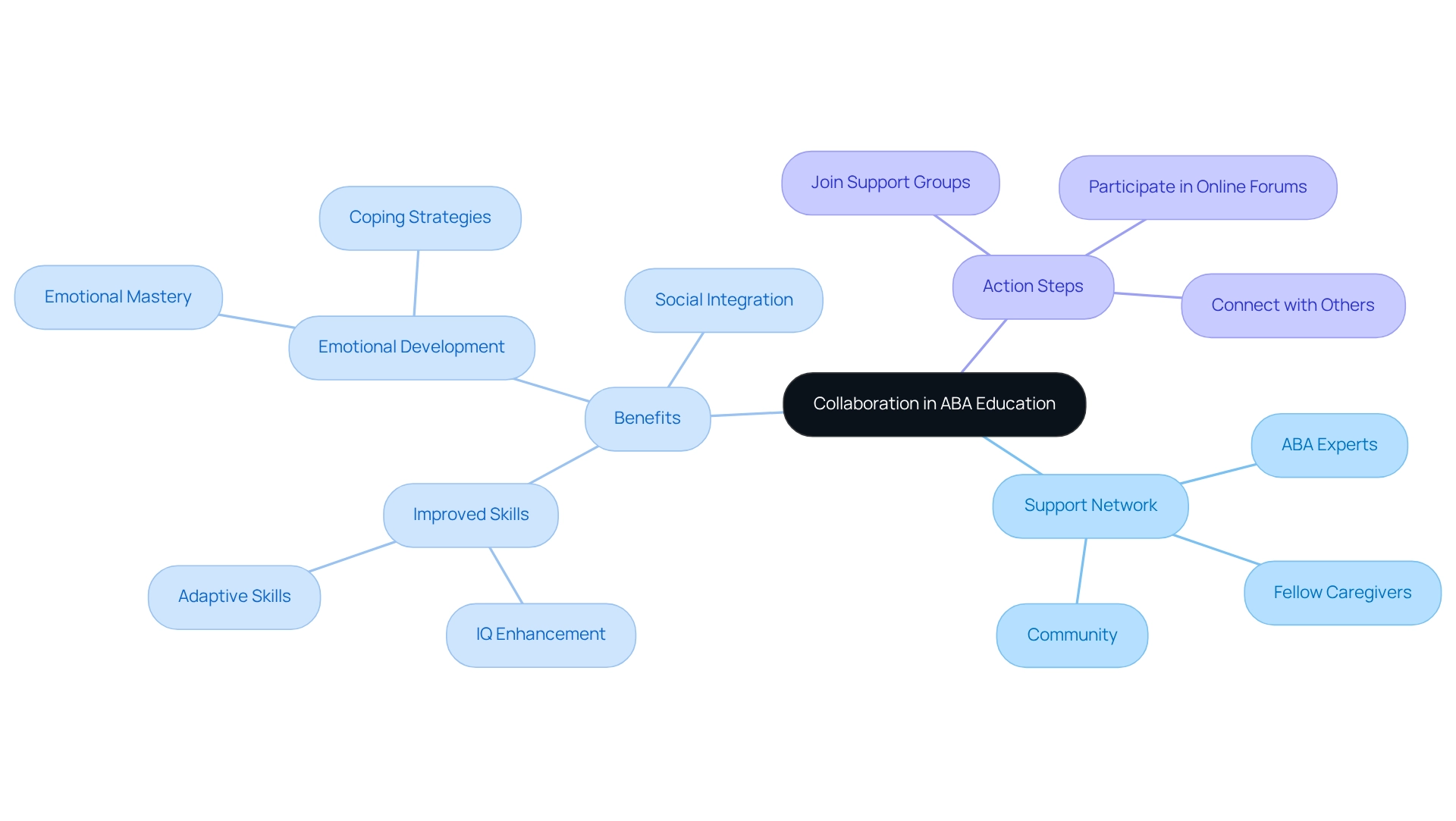
Navigating Challenges in ABA Education for Parents
Parents encounter a multitude of challenges in ABA education, particularly in 2025. Resistance from their child, difficulties in implementing strategies, and navigating the educational system can feel overwhelming. Research indicates that families often need ongoing adjustments to their routines and additional support to balance treatment demands with daily life. To navigate these challenges effectively, it is essential for parents to nurture patience and persistence. Actively seeking support from professionals and connecting with other parents in similar situations can make a significant difference. Developing a flexible mindset and being open to adapting strategies can greatly assist in overcoming these hurdles.
Case studies, such as 'How ABA Education Helps Youngsters with Autism Achieve Educational Success,' illustrate that personalized ABA education approaches not only enhance engagement in educational settings but also boost academic performance. By fostering teamwork and reducing stress through parent-led initiatives, families can create a more nurturing environment for their children. As ASD Media states, "Unlocking the Science of Behavior for Better Learning and Development," expert insights highlight the importance of resilience in overcoming these challenges. Successful strategies often involve open communication and a willingness to adjust expectations. Ultimately, embracing these insights empowers caregivers to unlock their child's potential and cultivate a positive learning experience.
Building a Supportive Community for Parents in ABA Education
Establishing a nurturing community is essential for caregivers involved in ABA education. By interacting with fellow caregivers through local or online support groups, you can find invaluable emotional support and a platform for sharing resources. Did you know that 36.5% of autism caregivers utilize ABA therapy? A majority of them report positive outcomes, which underscores the significant role that community plays in navigating the challenges of caregiving.
Families often encounter additional hurdles, including comorbid conditions like anxiety and ADHD. This reality highlights the necessity for a robust support network. By actively seeking workshops, events, and support groups, parents can cultivate connections that enrich their journey in ABA education, ultimately enhancing their children’s development and well-being.
We encourage you to explore the various support options available to you, ensuring that you do not have to walk this path alone. Remember, you are part of a community that understands and cares.
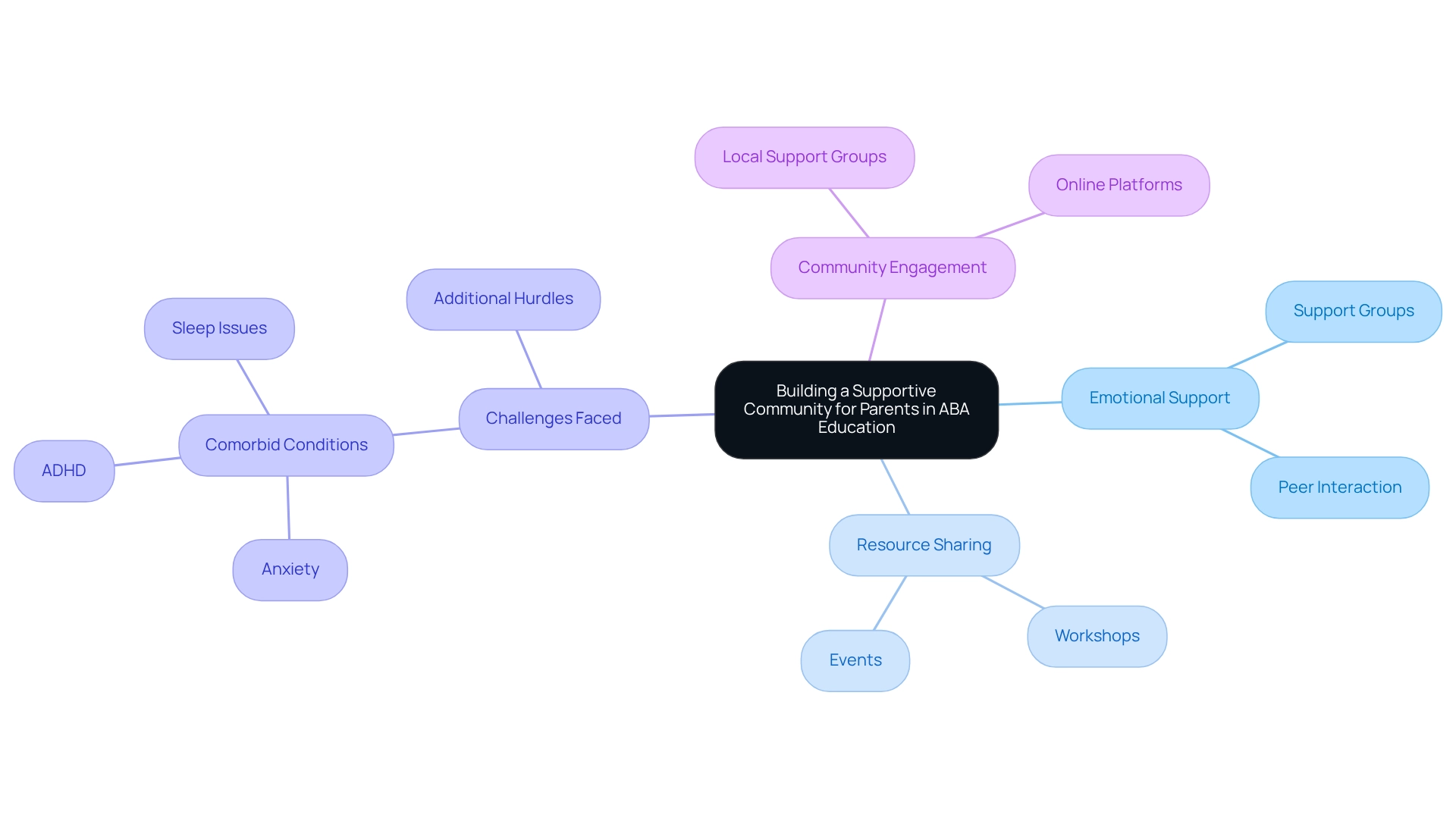
Conclusion
The journey through ABA education is filled with both challenges and opportunities for growth, making access to resources and support networks essential for parents and professionals alike. ASD Media stands out as a vital resource, offering a broad range of materials that empower families and educators to navigate the complexities of supporting children with autism and ADHD. By understanding the core principles of ABA and advocating for individualized education plans, parents can significantly enhance learning outcomes and foster a collaborative environment that promotes success.
Early intervention remains a key factor in optimizing developmental outcomes, reinforcing the idea that starting ABA therapy at a young age can lead to significant improvements in social interactions and academic performance. Utilizing effective techniques such as positive reinforcement and structured assessments allows parents and professionals to create tailored interventions that cater to each child's unique needs. As collaboration between parents, educators, and therapists becomes increasingly important, the establishment of a supportive community can provide the necessary encouragement and resources for families facing challenges in ABA education.
Ultimately, the collective commitment to understanding and implementing these strategies can unlock the potential of children with autism and ADHD, paving the way for meaningful progress in their educational journeys. By fostering open communication, engaging in ongoing assessments, and actively participating in support networks, parents can play a crucial role in their child's development and well-being. Embracing these principles and practices will not only enhance their child's learning experience but also contribute to a more informed and compassionate approach to ABA education.
Frequently Asked Questions
What resources does ASD Media provide for ABA education support?
ASD Media offers a variety of resources, including articles, webinars, and community forums, designed to support parents and professionals involved in ABA education. These resources address common challenges and share effective strategies.
Why is ongoing professional development important in ABA?
Ongoing professional development is essential for ABA therapists to stay informed about new research and techniques, which helps them provide the best support and interventions for individuals with autism and ADHD.
What are the core principles of Applied Behavior Analysis (ABA)?
The core principles of ABA include reinforcement, punishment, and the thoughtful use of antecedents to shape behavior. These principles are crucial for creating personalized interventions that cater to individual needs.
How does positive reinforcement function in ABA?
Positive reinforcement involves using rewards such as verbal praise, tokens, or engaging activities to encourage desired behaviors, fostering an effective learning environment and enhancing skill development, especially in communication and social interactions.
What is the significance of early intervention in ABA education?
Early intervention in ABA education is vital as it enhances outcomes for children with autism and ADHD, helping them develop essential skills, improve social interactions, and achieve academic success.
What role do parents play in ABA education?
Parents are encouraged to actively collaborate with educators to ensure a consistent approach to reinforcement and punishment in their child's learning environment, which is crucial for effective interventions.
What does research say about the effectiveness of early ABA education?
Research indicates that early ABA education significantly aids in skill acquisition and helps children manage symptoms, leading to better relationships with family and peers. However, some children may experience mixed outcomes.
How can parents initiate early ABA education for their children?
Parents and guardians are strongly encouraged to seek evaluations and start interventions as soon as possible to fully harness the benefits of early ABA education, which can lead to lasting improvements in their child's development.




